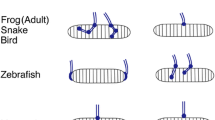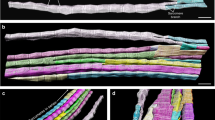Abstract
ADULT fast and slow skeletal muscle fibres contain different myosins, a result of innervation by different classes of motoneurones1; innervation of one fibre type by the opposite motoneurone type leads to a switch in the kind of myosin synthesised2,3 within pre-existing fibres4,5. In embryonic muscles, however, the particular myosin isozyme synthesised before and during the early stages of innervation has been a subject of controversy. Some investigators claim that all embryonic muscle fibres—whether destined to be fast or slow in the adult—initially synthesise both ftast and slow myosins6,7. Proper innervation would then lead to a selection of one myosin type and repression of the other type within each cell. Others propose that the myosin of embryonic muscles is a distinct myosin, unique to the embryo8,9. On the other hand, we have presented evidence that all fetal muscles have an intrinsic programme which causes them to synthesise fast myosin initially10,11. After innervation, fast muscles continue synthesising fast myosin, while slow muscles switch to the synthesis of slow myosin. Some studies have corroborated our findings12–14, but in all these studies the earliest fast and slow muscles that could be obtained were already innervated, and the slow muscles already contained a small amount of slow myosin. Accordingly, to examine the initial miyosin synthesised in both fast and slow muscles before innervation, we have cultured tissue from chicken muscles destined to be fast or slow muscles in the adult. Muscle fibres in tissue culture are formed in the complete absence of innervation. Whether established from presumptive fast or presumptive slow muscles, all fibres in culture synthesised only fast myosin heavy and light chains.
Similar content being viewed by others
References
Buller, A., Eccles, J. & Eccles, R. J. Physiol. Lond. 150, 399–416 (1960).
Weeds, A., Trentham, D., Kean, C. & Buller, A. Nature 247, 135–139 (1974).
Sreter, F., Elzinga, M., Mabuchi, K., Salmons, S. & Luff, A. FEBS Lett. 57, 107–111 (1975).
Pette, D. & Schnez, U. FEBS Lett. 83, 128–130 (1977).
Rubinstein, N. et al. J. Cell Biol. 79, 252–261 (1978).
Masaki, T. & Yoshizaki, C. J. Biochem. 76, 123–131 (1974).
Gauthier, G., Lowey, S. & Hobbs, A. Nature 274, 25–29 (1978).
Whalen, R., Butler-Browne, G. & Gros, F. J. molec. Biol. 126, 415–431 (1978).
Sreter, F., Balint, M. & Gergely, J. Devl. Biol. 46, 317–325 (1975).
Rubinstein, N., Pepe, F. & Holtzer, H. Proc. natn. Acad. Sci. U.S.A. 74, 4524–4527 (1977).
Rubinstein, N. & Kelly, A. Devl. Biol. 62, 473–485 (1978).
Pelloni-Müller, G., Ermini, M. & Jenny, E. FEBS Lett. 67, 68–74 (1976).
Syrovy, I. & Gutmann, E. Pflügers Arch. ges. Physiol. 369, 85–89 (1977).
Pette, D., Vrbova, G. & Whalen, R. Pflügers Arch. ges. Physiol. 378, 251–257 (1979).
Arndt, I. & Pepe, F. J. Histochem. Cytochem. 23, 159–168 (1975).
Masaki, T. J. Biochem. 76, 441–449 (1974).
Pepe, F. Cold Spring Har. Symp. quant. Biol. 37, 97–108 (1972).
Bruggmann, S. & Jenny, E. Biochim. biophys. Acta 412, 39–50 (1975).
O'Farrell, P. J. biol. Chem. 259, 4007–4021 (1975).
Y'ablonka, Z. & Yaffe, D. Differentiation 8, 133–143 (1977).
Dow, J. & Stracher, A. Proc. natn. Acad. Sci. U.S.A. 68, 1107–1110 (1971).
Chi, J., Rubinstein, N., Strahs, K. & Holtzer, H. J. Cell Biol. 67, 523–537 (1975).
Salmons, S. & Vrbova, G. J. Physiol. Lond. 201, 535–549 (1969).
Sreter, F., Gergely, J., Salmons, S. & Romanul, F. Nature 241, 17–18 (1973).
Salmons, S. & Sreter, F. Nature 263, 30–34 (1976).
Author information
Authors and Affiliations
Rights and permissions
About this article
Cite this article
RUBINSTEIN, N., HOLTZER, H. Fast and slow muscles in tissue culture synthesise only fast myosin. Nature 280, 323–325 (1979). https://doi.org/10.1038/280323a0
Received:
Accepted:
Issue Date:
DOI: https://doi.org/10.1038/280323a0
- Springer Nature Limited
This article is cited by
-
Characterization of a human genomic DNA fragment coding for a myosin heavy chain
Human Genetics (1983)
-
The effect of denervation on the distribution of the polymorphic forms of troponin components in fast and slow muscles of the adult rat
Cell and Tissue Research (1982)
-
Three myosin heavy-chain isozymes appear sequentially in rat muscle development
Nature (1981)
-
Myosin heavy chains in fast skeletal muscle of chick embryo
Experientia (1981)
-
The influence of electrical activity on the development of newborn innervated rat muscles
Pflügers Archiv - European Journal of Physiology (1981)





